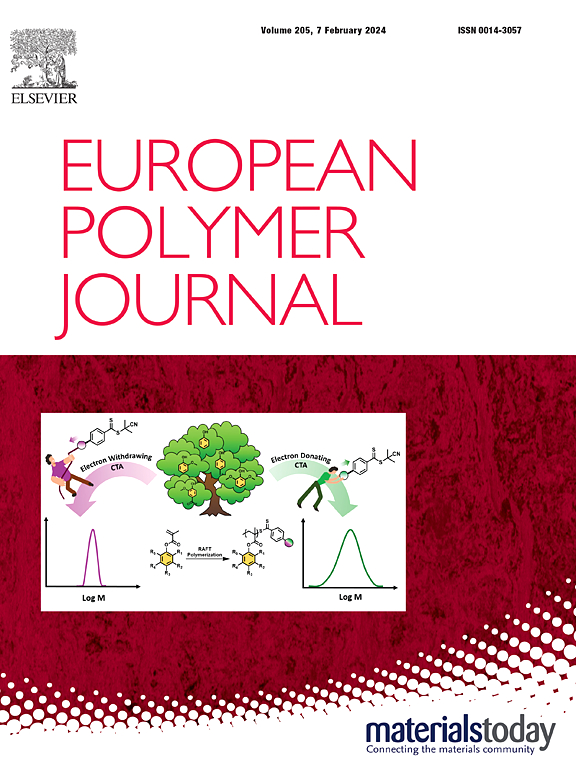Preparation and evaluation of p(2-hydroxyethyl methacrylate-co-Acrylamide)/ gelatin/ ammonium polyhedral oligomeric silsesquioxane composite as a candidate for full-thickness wound dressing
IF 5.8
2区 化学
Q1 POLYMER SCIENCE
引用次数: 0
Abstract
Skin infections and wounds are the major public health concerns in the world. The use of effective wound dressings is essential for post-surgical wound assessment. In this study, novel hydrogel films containing interpenetrating polymer networks (IPN) were formed from poly (2-hydroxyethyl methacrylate) (pHEMA), acrylamide (AM), gelatin, and modified polyhedral oligomeric silsesquioxane (POSS) nanoparticles containing ammonium antibacterial functional groups designed for use as wound dressing. Samples were analyzed via infrared spectroscopy (FTIR), scanning electron microscopy (SEM), and contact angle. In addition, several characteristics, such as swelling ratio, water vapor transmission rate (WVTR), mechanical and thermal properties, cell viability, and antibacterial activity were examined. The incorporation of POSS-NH3+ enhanced the mechanical properties of the hydrogel, while the simultaneous inclusion of POSS-NH3+ with heparinized nano zinc oxide (HP-nZnO) in the structure significantly improved antibacterial activity. Additionally, SEM microscopy revealed a smooth surface morphology, and the nanoparticle-loaded composite samples showed no toxicity, with cell viability exceeding 90 % in optimized samples tested with fibroblast L929 cells. Furthermore, the hydrogel demonstrated effective antibacterial properties, particularly with HP-nZnO, making them effective for wound protection. In vivo studies confirmed that the p(HEMA-co-AM)/gelatin/POSS/nZnO wound dressing is a promising candidate for treating skin injuries.

p(2-羟乙基甲基丙烯酸酯-共丙烯酰胺)/明胶/铵多面体低聚硅氧烷复合材料全层创面敷料的制备及评价
皮肤感染和伤口是世界上主要的公共卫生问题。使用有效的伤口敷料对术后伤口评估至关重要。在这项研究中,由聚(2-羟乙基甲基丙烯酸酯)(pHEMA)、丙烯酰胺(AM)、明胶和含有铵抗菌官能团的改性多面体低聚硅氧烷(POSS)纳米颗粒组成的新型水凝胶膜含有互穿聚合物网络(IPN),设计用于伤口敷料。通过红外光谱(FTIR)、扫描电镜(SEM)和接触角对样品进行分析。此外,还考察了膨胀比、水蒸气透过率(WVTR)、机械和热性能、细胞活力和抗菌活性等几个特性。POSS-NH3+的掺入增强了水凝胶的力学性能,而在结构中同时包裹肝素化纳米氧化锌(HP-nZnO)则显著提高了水凝胶的抗菌活性。此外,扫描电镜显示,纳米颗粒负载的复合材料样品表面形貌光滑,没有毒性,优化后的样品与成纤维细胞L929细胞一起测试,细胞存活率超过90%。此外,水凝胶显示出有效的抗菌性能,特别是HP-nZnO,使其有效地保护伤口。体内研究证实,p(HEMA-co-AM)/明胶/POSS/nZnO创面敷料是治疗皮肤损伤的有希望的候选材料。
本文章由计算机程序翻译,如有差异,请以英文原文为准。
求助全文
约1分钟内获得全文
求助全文
来源期刊

European Polymer Journal
化学-高分子科学
CiteScore
9.90
自引率
10.00%
发文量
691
审稿时长
23 days
期刊介绍:
European Polymer Journal is dedicated to publishing work on fundamental and applied polymer chemistry and macromolecular materials. The journal covers all aspects of polymer synthesis, including polymerization mechanisms and chemical functional transformations, with a focus on novel polymers and the relationships between molecular structure and polymer properties. In addition, we welcome submissions on bio-based or renewable polymers, stimuli-responsive systems and polymer bio-hybrids. European Polymer Journal also publishes research on the biomedical application of polymers, including drug delivery and regenerative medicine. The main scope is covered but not limited to the following core research areas:
Polymer synthesis and functionalization
• Novel synthetic routes for polymerization, functional modification, controlled/living polymerization and precision polymers.
Stimuli-responsive polymers
• Including shape memory and self-healing polymers.
Supramolecular polymers and self-assembly
• Molecular recognition and higher order polymer structures.
Renewable and sustainable polymers
• Bio-based, biodegradable and anti-microbial polymers and polymeric bio-nanocomposites.
Polymers at interfaces and surfaces
• Chemistry and engineering of surfaces with biological relevance, including patterning, antifouling polymers and polymers for membrane applications.
Biomedical applications and nanomedicine
• Polymers for regenerative medicine, drug delivery molecular release and gene therapy
The scope of European Polymer Journal no longer includes Polymer Physics.
 求助内容:
求助内容: 应助结果提醒方式:
应助结果提醒方式:


